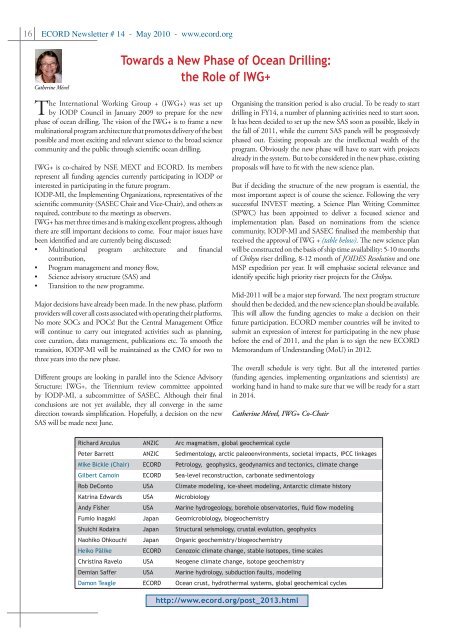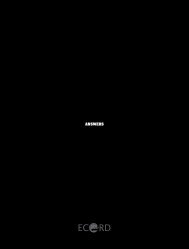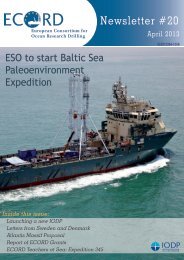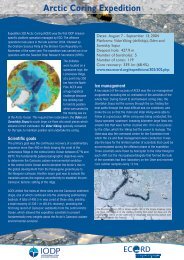14 - European Consortium for Ocean Research Drilling
14 - European Consortium for Ocean Research Drilling
14 - European Consortium for Ocean Research Drilling
- No tags were found...
You also want an ePaper? Increase the reach of your titles
YUMPU automatically turns print PDFs into web optimized ePapers that Google loves.
16 ECORD Newsletter # <strong>14</strong> - May 2010 - www.ecord.orgCatherine MévelTowards a New Phase of <strong>Ocean</strong> <strong>Drilling</strong>:the Role of IWG+The International Working Group + (IWG+) was set upby IODP Council in January 2009 to prepare <strong>for</strong> the newphase of ocean drilling. The vision of the IWG+ is to frame a newmultinational program architecture that promotes delivery of the bestpossible and most exciting and relevant science to the broad sciencecommunity and the public through scientific ocean drilling.IWG+ is co-chaired by NSF, MEXT and ECORD. Its membersrepresent all funding agencies currently participating in IODP orinterested in participating in the future program.IODP-MI, the Implementing Organizations, representatives of thescientific community (SASEC Chair and Vice-Chair), and others asrequired, contribute to the meetings as observers.IWG+ has met three times and is making excellent progress, althoughthere are still important decisions to come. Four major issues havebeen identified and are currently being discussed:• Multinational program architecture and financialcontribution,• Program management and money flow,• Science advisory structure (SAS) and• Transition to the new programme.Major decisions have already been made. In the new phase, plat<strong>for</strong>mproviders will cover all costs associated with operating their plat<strong>for</strong>ms.No more SOCs and POCs! But the Central Management Officewill continue to carry out integrated activities such as planning,core curation, data management, publications etc. To smooth thetransition, IODP-MI will be maintained as the CMO <strong>for</strong> two tothree years into the new phase.Different groups are looking in parallel into the Science AdvisoryStructure: IWG+, the Triennium review committee appointedby IODP-MI, a subcommittee of SASEC. Although their finalconclusions are not yet available, they all converge in the samedirection towards simplification. Hopefully, a decision on the newSAS will be made next June.Organising the transition period is also crucial. To be ready to startdrilling in FY<strong>14</strong>, a number of planning activities need to start soon.It has been decided to set up the new SAS soon as possible, likely inthe fall of 2011, while the current SAS panels will be progressivelyphased out. Existing proposals are the intellectual wealth of theprogram. Obviously the new phase will have to start with projectsalready in the system. But to be considered in the new phase, existingproposals will have to fit with the new science plan.But if deciding the structure of the new program is essential, themost important aspect is of course the science. Following the verysuccessful INVEST meeting, a Science Plan Writing Committee(SPWC) has been appointed to deliver a focused science andimplementation plan. Based on nominations from the sciencecommunity, IODP-MI and SASEC finalised the membership thatreceived the approval of IWG + (table below). The new science planwill be constructed on the basis of ship time availability: 5-10 monthsof Chikyu riser drilling, 8-12 month of JOIDES Resolution and oneMSP expedition per year. It will emphasise societal relevance andidentify specific high priority riser projects <strong>for</strong> the Chikyu.Mid-2011 will be a major step <strong>for</strong>ward. The next program structureshould then be decided, and the new science plan should be available.This will allow the funding agencies to make a decision on theirfuture participation. ECORD member countries will be invited tosubmit an expression of interest <strong>for</strong> participating in the new phasebe<strong>for</strong>e the end of 2011, and the plan is to sign the new ECORDMemorandum of Understanding (MoU) in 2012.The overall schedule is very tight. But all the interested parties(funding agencies, implementing organizations and scientists) areworking hand in hand to make sure that we will be ready <strong>for</strong> a startin 20<strong>14</strong>.Catherine Mével, IWG+ Co-ChairRichard Arculus ANZIC Arc magmatism, global geochemical cyclePeter Barrett ANZIC Sedimentology, arctic paleoenvironments, societal impacts, IPCC linkagesMike Bickle (Chair) ECORD Petrology, geophysics, geodynamics and tectonics, climate changeGilbert Camoin ECORD Sea-level reconstruction, carbonate sedimentologyRob DeConto USA Climate modeling, ice-sheet modeling, Antarctic climate historyKatrina Edwards USA MicrobiologyAndy Fisher USA Marine hydrogeology, borehole observatories, fluid flow modelingFumio Inagaki Japan Geomicrobiology, biogeochemistryShuichi Kodaira Japan Structural seismology, crustal evolution, geophysicsNaohiko Ohkouchi Japan Organic geochemistry/biogeochemistryHeiko Pälike ECORD Cenozoic climate change, stable isotopes, time scalesChristina Ravelo USA Neogene climate change, isotope geochemistryDemian Saffer USA Marine hydrology, subduction faults, modelingDamon Teagle ECORD <strong>Ocean</strong> crust, hydrothermal systems, global geochemical cycleshttp://www.ecord.org/post_2013.html







